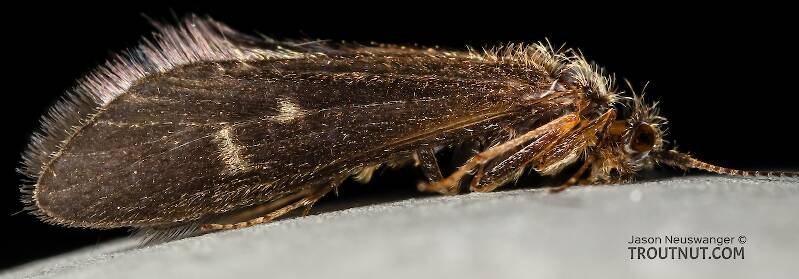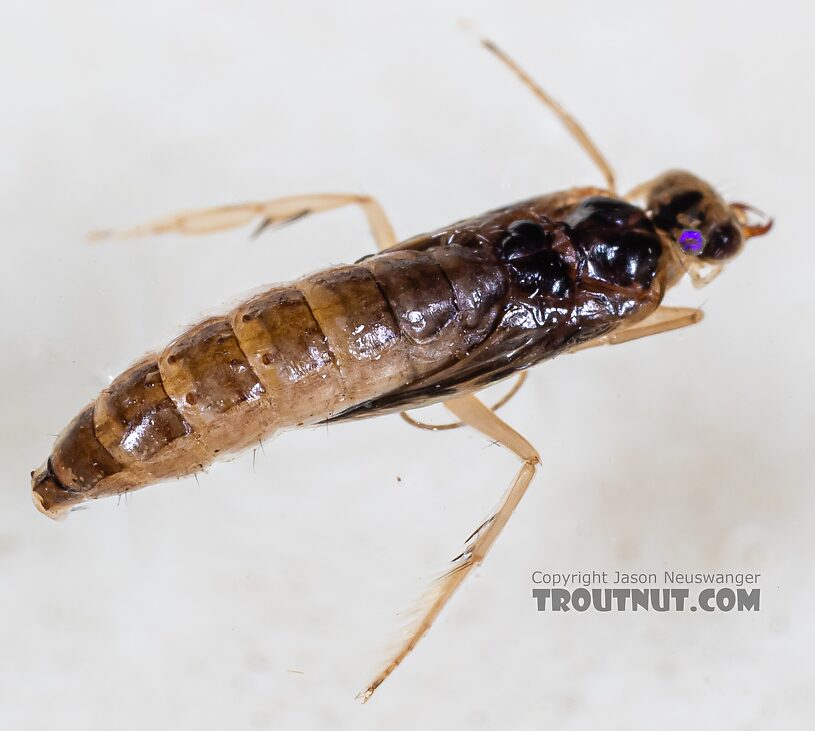
Hex Mayflies
Hexagenia limbata
The famous nocturnal Hex hatch of the Midwest (and a few other lucky locations) stirs to the surface mythically large brown trout that only touch streamers for the rest of the year.
Featured on the forum

Nymphs of this species were fairly common in late-winter kick net samples from the upper Yakima River. Although I could not find a key to species of Zapada nymphs, a revision of the Nemouridae family by Baumann (1975) includes the following helpful sentence: "2 cervical gills on each side of midline, 1 arising inside and 1 outside of lateral cervical sclerites, usually single and elongate, sometimes constricted but with 3 or 4 branches arising beyond gill base in Zapada cinctipes." This specimen clearly has the branches and is within the range of that species.

Troutnut is a project started in 2003 by salmonid ecologist Jason "Troutnut" Neuswanger to help anglers and
fly tyers unabashedly embrace the entomological side of the sport. Learn more about Troutnut or
support the project for an enhanced experience here.
Caddisfly Species Helicopsyche borealis (Speckled Peters)
This is the only important trout stream species of Helicopsyche. It has an unusual wing characteristic, described by Gary LaFontaine in Caddisflies:
The adult appears different in flight from other caddisflies because the top set of wings is attached to the bottom by a row of hooks, so the four wings beat together, not as two spread-out sets.
Where & when
The emergence of this species lasts a few weeks in any given location. It begins in the East in early May and lasts through June, while in the West it begins in mid-June and lasts through early July.
In 137 records from GBIF, adults of this species have mostly been collected during June (23%), July (21%), August (19%), May (12%), September (9%), and April (8%).
In 92 records from GBIF, this species has been collected at elevations ranging from 195 to 10194 ft, with an average (median) of 3509 ft.
Species Range
Egg-Laying behavior
Time of day: Evening
During egg laying, the females float in the surface close to the banks, crawl underwater, and flop on the surface to oviposit. They then ride the water serenely in the normal resting position, and trout take them with gentle rises.
Larva & pupa biology
Diet: Algae, detritus, animal matter
Environmental tolerance: Very tolerant: can thrive in both cold water and hot springs up to 110°F
Shelter type: Coiled sand case shaped like a snail shell
Specimens of the Caddisfly Species Helicopsyche borealis
1 Female Adult

This one keys pretty easily to the Helicopsychidae family, of which there is only one genus in North America, and one species reported in this general area.
1 Pupa

I'm calling this one very tentatively Helicopsyche borealis, with some big caveats that I might be wrong.
It seems to key fairly easily to Helicopsychidae, except at the last couplet in Merritt & Cummins (5th ed) it's supposed to have “anal processes short and straight, each with several mesal setae and 2 long apical setae,” whereas this one has VERY short, straight processes with 3 long apical setae and no mesal ones.
Additionally, the only species of Helicopsychidae documented in this region is Helicopsyche borealis, which is supposed to emerge much later in the summer.
It seems to key fairly easily to Helicopsychidae, except at the last couplet in Merritt & Cummins (5th ed) it's supposed to have “anal processes short and straight, each with several mesal setae and 2 long apical setae,” whereas this one has VERY short, straight processes with 3 long apical setae and no mesal ones.
Additionally, the only species of Helicopsychidae documented in this region is Helicopsyche borealis, which is supposed to emerge much later in the summer.
Start a Discussion of Helicopsyche borealis
References
- Baumann, Richard W. 1975. Revision of the Stonefly Family Nemouridae (plecoptera) : a Study Of The World Fauna At The Generic Level. Smithsonian Contributions to Zoology undef(211): 1-74.
- LaFontaine, Gary. 1981. Caddisflies. The Lyons Press.
- Swisher, Doug and Carl Richards. 2000. Selective Trout. The Lyons Press.
Caddisfly Species Helicopsyche borealis (Speckled Peters)
Species Range
Common Name
Resources
- NatureServe
- Integrated Taxonomic Information System
- Global Biodiversity Information Facility
- Described by Hagen (1861)

